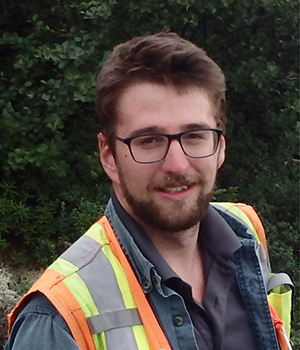Since the expeditions of Albert P. Low and the Geological Survey of Canada between 1884 and 1905, countless geologists and prospectors have roamed and explored the Eeyou Istchee James Bay territory. Despite the many phases of geoscience knowledge acquisition carried out over these 125 years of mineral exploration by the various players, new discoveries of critical and strategic minerals and metals in recent years demonstrate that this territory is still considered one of the “new” frontiers for mineral exploration. This conference session aims to prove, once more, that the Eeyou Istchee James Bay territory still holds in store many surprises, thanks to its highly diversified geological and metallogenic environments.
Eeyou Istchee James Bay: a century-old history of a geoscientific frontier
Wednesday, November 20, 2024
Room 403


9:05 a.m.
The Virginia Odyssey in James Bay: Two Decades of Exploration in Eeyou Istchee James Bay

Virginia Mines has been a pioneer and undisputed leader of mining exploration in Quebec's Middle North. Since arriving in Eeyou Istchee James Bay in 1994, Virginia has made no fewer than six major discoveries, including the Eleonore gold deposit, currently in production, the Coulon Volcanic Belt containing Cu-Zn-Ag resources of nearly 14 Mt, the 32 (La Grande Sud), Orfée (Poste Lemoyne Extension) and Marco (Corvet Est) gold-bearing zones, all of which contain considerable gold resources, and lastly, significant Ni-Pd-Pt resources in the Venus Ultramafic Belt (Gayot). Virginia's work in this area has also led to the discovery of a multitude of mineralized showings of all kinds, and has had a major impact on our understanding of the area's metallogeny.
Between 1994 and 2014, Virginia alone invested more than $80 million in exploration work in this promising area. In the process, it has attracted more than $40 million in investment from its partners. These investments have had a major positive impact, with the gross in situ value of Virginia's discoveries estimated at over $16 billion. Virginia's success has attracted a number of other exploration companies, which have in turn made major investments in the region.
Virginia's impact can also be seen in its relationship with First Nations, an area in which it has established itself as a leader by adopting a communication model that is cited as an example by all stakeholders in the region. Virginia has also been instrumental in training a new generation of geoscientists and exploration leaders.
Virginia's achievements are no accident, but rather the fruit of a judicious exploration strategy based on four key principles: focusing its activities on a promising area open to exploration, acquiring and diversifying a large portfolio of properties, forging numerous partnerships that make it possible to share the risks inherent to exploration and maintain a long-term presence in the area, and lastly, developing a renowned expertise. This strategy has been extremely profitable for Virginia over the 1994-2014 period.
The search for deposits that deviate from conventional metallogenic models and the development of renowned expertise in Eeyou Istchee James Bay represent a valuable asset, if not a necessity, for those seeking to explore this new frontier successfully.
9:45 a.m.
Geology, Geochronology and Metallogeny of the Upper Eastmain Volcano-Sedimentary Sequence
Geologists from the Geological Survey of Canada were the first to recognize the presence of a major volcano-sedimentary sequence north of the Otish Mountains (Eade, 1965), before Hocq (1985) came along to define it more formally. From 2016 to 2018, three mapping campaigns carried out by the MRNF were conducted to define the extent of this sequence, now known as the Upper Eastmain Greenstone Belt (UEGB), and to understand its significance. Historical data, coupled with new geochronological analyses and improved geophysical coverage, have enabled us to establish a more coherent stratigraphy and a more complete structural evolution for the atypical geometry of the monstrous UEGB.
This improved understanding is reflected in our knowledge of the metallogeny of the UEGB, particularly in the case of the former Eastmain gold mine. Since the MRNF's mapping campaigns, numerous gold and copper showings have been identified. Large shear zones along each branch of the belt have been defined as potential conduits for mineralizing fluids. Very recently, the discovery of lithium mineralization has rekindled exploration in the area. More players are appearing, and new discoveries are being added to the old ones.
Exploration in the area is still in its early stages, despite road access. And who knows, perhaps we have underestimated the extent of the sequence and its possible links with other volcano-sedimentary units in the area...
10:05 a.m.
Break
10:20 a.m.
Stratigraphic Revision of the Volcano-Sedimentary Sequence of the Lac Des Montagnes Belt and Implications for Regional Metallogeny: Examples of Cu-Ag ± Zn Showings From Lac Lemare-Ouest and Lac Voirdye

The Lac des Montagnes Belt (LMB), located at the contact between the La Grande and Opatica subprovinces, is known to host several types of mineralization. A number of recent studies have enhanced our geoscientific knowledge of this region. However, the stratigraphic sequence currently defined is a combination of Mesoarchean and Neoarchean rocks, often grouped together in the same units.
The current study shows that the LMB comprises a Mesoarchean sequence at the base, overlain by a Neoarchean sequence. The basal sequence is composed of Mesoarchean volcanic rocks (2838 to 2821 Ma) resting concordantly on an ancient basement, also Mesoarchean (Théodat Complex 1; 2843 ±7 to 2797.1 ±5 Ma). One of the characteristics of this Mesoarchean sequence is the presence of metasomatic rocks of varying compositions (depending on the protolith). The main alterations observed are aluminous (garnet-sillimanite-cordierite), magnesian (anthophyllite), potassic ± chromiferous (biotite-sericite ± fuchsite) and siliceous (quartz). Stratiform Cu-Ag ± Zn mineralizations are spatially associated with these metasomatites. A Mesoarchean fuchsite-bearing quartzite sequence (Voirdye Formation 3; <2819.4 ±2.9 Ma) stratigraphically overlies the intrusive and volcano-sedimentary rocks. At the top, the Neoarchean paragneiss of the Voirdye Formation 2 (<2708.2 ±4.6 Ma) uncomformably overlies the Mesoarchean sequence. All these rocks are cut by pegmatite injections (Senay Suite; ~2640 Ma).
This stratigraphic review highlights the mineral potential of the Mesoarchean rocks in the area. The ages indicate that emplacement of the Théodat Complex was partly synchronous with the deposition of the Mesoarchean volcano-sedimentary rocks. Field relationships suggest that the metasomatism affecting the Mesoarchean rocks was syngenetic in origin and that these altered rocks were metamorphosed to the middle amphibolite facies. The nature, extent and intensity of this metasomatism increases the potential for the discovery of new types of mineralization: 1) porphyritic; 2) acidic epithermal, in the intrusive units forming the ancient basement, often considered as barren; and 3) exhalative mineralization of the volcanogenic massive sulphides (VMS) type in the volcano-sedimentary rocks. These Mesoarchean units represent regional benchmark layers that constitute the hypothetical boundary of a Mesoarchean palaeorifting zone. These preliminary interpretations open up a large area of high potential at the edge of the LMB, along the contact between the Opatica and La Grande subprovinces, which extends laterally over more than 250 km.
10:40 a.m.
Geology of the Michaux Lake Area, Opatica and la Grande Subprovinces, Eeyou Istchee James Bay, Quebec, Canada

MRNF
The geological survey of the Michaux Lake area, carried out during the summer of 2023, covers sheet 32P13, located approximately 200 km north of Chibougamau and 160 km east of Nemaska, to the south of the Eastmain River. The northern part of the area is the eastern extension of the Lac des Montagnes Belt (La Grande Subprovince). It consists mainly of a metasedimentary package assigned to the Voirdye Formation (biotite ± garnet paragneiss, biotite-garnet paragneiss ± cordierite ± sillimanite, arenite, quartzite, iron formation), locally migmatitized, containing large injections of white granitic pegmatite featuring biotite ± garnet ± muscovite ± tourmaline. The sedimentary sequence was partly deposited on the volcanic sequence of the Lac des Montagnes Group or is found in structural contact with the plutonic and gneissic rocks of the Hutte and Théodat complexes, which are interpreted as basement rocks. The volcanic sequence consists of thin discontinuous bands of amphibolitized basalt or felsic to intermediate volcaniclastite, 200 m to 1 km wide and up to 5 km long. It is generally located at the contact with the Théodat Complex or the gneissic domes of the Hutte Complex. Kilometric mafic-ultramafic intrusions are found within volcanic and metasedimentary sequences. The southern part of the sector is represented by the Opatica Subprovince, made up of tonalitic gneiss, tonalite, granodiorite, quartz monzodiorite, porphyroid granodiorite and granite assigned to the Théodat Complex. The latter contains three major bands of E-W trending volcanosedimentary rocks, 10 km to 18 km long and 100 m to 500 m wide, which have been assigned to the Michaux Group (new unit). These bands generally contain peridotite and pyroxenite sills. All the rocks in the region, with the exception of late intrusive rocks, exhibit diffuse and relatively homogeneous deformation, characterized by penetrative foliation. This foliation is mainly oriented E-W to NW-SE and dips steeply in the La Grande area, whereas it is structured into domes and basins in the Opatica. Our work demonstrates that the La Grande-Opatica contact constitutes a major regional metallotect that extends over hundreds of kilometres. Prospective zones for different types of mineralization have been identified: 1) polymetallic mineralization of the VMS type; 2) mineralization associated with banded iron formations of the Algoma type; 3) Ni-Cu-PGE mineralization associated with mafic-ultramafic intrusions; 4) lithium-tantalum-caesium potential associated with white pegmatites; 5) gold mineralization associated with deformation zones.
11:00 a.m.
Atypical Base Metal and Gold Mineralization Associated With Late Archean Granites and Paleoproterozoic Faults in the la Grande Subprovince

The La Grande Subprovince has a complex geological history spanning more than a billion years, from the Palaeoarchean to the Palaeoproterozoic. It contains numerous metallic mineralizations associated with the various volcano-plutonic Archean events and regional deformation episodes. More recently, lithium-cesium-tantalum (LCT) mineralization associated with late granite and pegmatite has attracted significant attention. However, other lesser-known contexts of gold and base metal mineralization are emerging from recent exploration work in different parts of the subprovince.
Several lithium showings in the La Grande Subprovince were emplaced along the same major metallotects that control gold mineralization, such as the La Grande-Opinaca or La Grande-Nemiscau contacts. Exploration data collected by Midland Exploration over the years on the Komo and Elrond projects show that several LCT pegmatites are strongly anomalous in gold-bismuth-molybdenum, suggesting a genetic link between these mineralizations and the gold mineralizations associated with these same intrusions.
The large Paleoproterozoic faults of the La Grande are known for their potential in uranium and 5-element veins (Bi-Co-Ni-Ag-U). Midland Exploration's work in the eastern part of this subprovince has identified several examples of undeformed copper-molybdenum mineralization associated with late faults that cut Archean high-grade metamorphic rocks. These mineralizations are accompanied by quartz vein stockwerks displaying open-space crystallization structures and intense ankerite-epidote-chlorite-potassium feldspar alteration. Their structural and mineralogical characteristics indicate that these veins are associated with events subsequent to regional metamorphism. The regional context of the faults associated with these copper-molybdenum mineralizations suggests that they were emplaced during the Paleoproterozoic. This is a new type of mineralization whose potential remains to be explored.
11:20 a.m.
The Emergence of a World-Class Lithium Province: Dynamics of an Exploration Boom and Development Perspectives in the Eeyou Istchee James Bay Region, Quebec.

The Eeyou Istchee James Bay region (175,000 km2) in Quebec is experiencing an unprecedented lithium exploration boom. To date, eight spodumene pegmatite deposits with estimated reserves and/or resources totalling 502 Mt have been delineated, including two deposits with tonnages exceeding 100 Mt: CV5 of Patriot Battery Metals and Galaxy of Arcadium Lithium. Furthermore, at least 10 major prospects, validated by drilling, have been identified since 2022, suggesting the potential for significant additional resources.
A quantitative analysis of these discoveries over time highlights the main components of this boom and provides predictive insights regarding its evolution. The regional-scale spatial distribution of discovered deposits and prospects, including two emerging districts (centred around the CV5 deposit of Patriot and the Adina deposit of Winsome Resources), allows for hypotheses on the regional controls of these mineralized systems.
The global demand for new lithium deposits, combined with the confirmation of James Bay as a geologically highly prospective area for lithium, has attracted a new wave of Canadian and international explorers. This has also prompted Quebec companies to reconsider the lithium potential of numerous existing projects. This lithium rush is facilitated by the quality of geoscientific data available in Quebec, including regional surveys of multi-element geochemistry of lake sediments, magnetic surveys, geological mapping, as well as existing infrastructure (access roads, hydro power lines, airports). The participation of the Cree Nation is also a key factor in this success.
Finally, a comparison of the lithium-bearing mineralized systems in the James Bay region with those in Western Australia (which accounts for 50% of global lithium production, with 1.3 billion tonnes in reserves and resources) reveals many common characteristics. The main difference lies in Quebec’s early stage of exploration, suggesting enormous potential for additional discoveries. Quebec is well positioned to become a major lithium producer in North America. The provincial and federal governments support the creation of a complete value chain to connect the lithium extraction hub in James Bay to the green energy manufacturing hub in southern Quebec.
11:40 a.m.
Crustal Growth and Tectonometamorphic Evolution of the Southeastern Superior Province (Canada): A Long-Lasting History
The Nemiscau Subprovince in the central part of the Superior Province in Quebec is bounded to the north and south by the volcano-plutonic subprovinces of La Grande and Opatica. It has generally been interpreted as the remains of an accretionary complex or synorogenic basin formed during the Kenorean Orogeny. The Nemiscau Subprovince is made up of metasedimentary rocks (≤ 2724 Ma), gneiss and migmatitized felsic to intermediate plutonic suites (2722 to 2671 Ma). Belts of metavolcanic rocks outcrop along its northern (2710 Ma) and southern (2760 to 2756 Ma) boundaries. The La Grande Subprovince also contains metasedimentary rocks (≤ 2706 Ma) and metavolcanic rocks (2723 to 2703 Ma). These supracrustal sequences are separated from the La Grande and Opatica plutonic domains by shear zones that do not coincide with major metamorphic jumps in the rocks on either side.
By integrating structural, metamorphic and geochronological data, it is possible to distinguish several deformation and metamorphic events in the SE Superior Province between 2815 and 2536 Ma. Two distinct tectonometamorphic events, pre-D1 (2815 to 2804 Ma) and D1 (2756 to 2736 Ma), are preserved locally. The D2 event reflects regional compressive deformation accommodated by the vertical creep of crustal material (2704 and 2671 Ma) coinciding with sanukitoid magmatism in volcano-plutonic subprovinces (2704 to 2693 Ma) and M2 metamorphism accompanied by anatexis in the Nemiscau (2697 to 2685 Ma). A symmetrical increase in the metamorphic gradient in the Nemiscau Basin during M2, varying from the amphibolite facies (742.5°C, 0.435 GPa) at the edge to the granulite facies (830°C, 0.87 GPa) at the core, is thought to be related to delamination of the lower crust. The La Grande metasedimentary rocks were metamorphosed to the amphibolite facies (640°C, 0.42 GPa). During D3 (2658 to 2621 Ma), regional deformation was expressed by transpression and the formation of dextral shear zones under the metamorphic conditions of the lower amphibolite facies (M3; 623.5°C, 0.335 GPa). The 40Ar/39Ar ages obtained from the amphibole suggest a progressive focus of brittle-ductile D4 deformation accommodated by dextral (NW-SE) and sinister (NE-SW) strike-slip kinematics along major deformation corridors from 2598 Ma.
The synchronism of the deformation, metamorphism and magmatism within the La Grande, Nemiscau and Opatica subprovinces suggests that they probably represent a single composite terrane, implying a ‘verticalist’ emplacement model that is hardly compatible with a subduction-collision type dynamic between these three subprovinces.
12:00 p.m.
